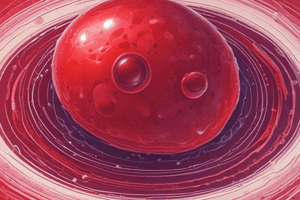Podcast
Questions and Answers
What is the main function of red blood cells in the human body?
What is the main function of red blood cells in the human body?
To transport oxygen from the lungs to the body's tissues and carbon dioxide back to the lungs.
What is the process called by which new red blood cells are produced in the bone marrow?
What is the process called by which new red blood cells are produced in the bone marrow?
Erythropoiesis
What are the three main types of blood cells in the human body?
What are the three main types of blood cells in the human body?
Red blood cells (RBCs), white blood cells (WBCs), and platelets.
What is the role of white blood cells in the immune system?
What is the role of white blood cells in the immune system?
What is the lifespan of a red blood cell?
What is the lifespan of a red blood cell?
What type of WBC is responsible for fighting bacterial infections?
What type of WBC is responsible for fighting bacterial infections?
What is the role of platelets in the body?
What is the role of platelets in the body?
What is the energy currency produced by cells through cellular respiration?
What is the energy currency produced by cells through cellular respiration?
What is the function of RBCs in gas transport and exchange?
What is the function of RBCs in gas transport and exchange?
What is the response of the immune system to threats?
What is the response of the immune system to threats?
Flashcards are hidden until you start studying
Study Notes
Blood and cell physiology is the study of the functions and interactions of blood components and cells in the human body. It encompasses various aspects such as blood formation, cellular respiration, transport of gases and nutrients, and the immune system's response to infections. Here are some key aspects of blood and cell physiology:
-
[Blood formation] Blood is the vital fluid that supplies oxygen and nutrients to the body's tissues and removes waste products. The three main types of blood cells are red blood cells (RBCs), white blood cells (WBCs), and platelets. RBCs transport oxygen from the lungs to the body's tissues and carbon dioxide back to the lungs. WBCs help fight infections and repair damaged tissues, while platelets are crucial for blood clotting and preventing excessive bleeding.
-
[Red Blood Cell Physiology] RBCs are the most abundant type of blood cell and contain a protein called hemoglobin, which is responsible for oxygen transport. The lifespan of a RBC is about 120 days, after which they are replaced by new cells produced in the bone marrow. The process of making new RBCs is called erythropoiesis, and it is regulated by the hormone erythropoietin.
-
[White Blood Cell Physiology] WBCs play a vital role in the immune system. They are produced in the bone marrow and are divided into two main types: leukocytes (neutrophils, lymphocytes, and monocytes) and agranulocytes (eosinophils and basophils). Neutrophils are the most abundant type of WBC and are involved in fighting bacterial infections. Lymphocytes are responsible for fighting viral and some bacterial infections, and they produce antibodies. Monocytes mature into macrophages, which are large phagocytic cells that engulf and destroy bacteria and other foreign particles. Eosinophils are involved in fighting parasitic infections and allergic reactions. Basophils release histamine, which causes inflammation and allergic reactions.
-
[Platelet Physiology] Platelets are small, disc-shaped cells that are formed from the fragmentation of megakaryocytes in the bone marrow. They play a crucial role in blood clotting, which is essential for stopping bleeding. When a blood vessel is damaged, platelets aggregate at the site of injury and release chemicals that activate the coagulation cascade, ultimately forming a fibrin clot.
-
[Oxygen Transport and Cellular Respiration] Oxygen is transported from the lungs to the body's tissues by RBCs, where it is used in cellular respiration. Cellular respiration is the process by which cells produce ATP (adenosine triphosphate), the energy currency of the cell. This process occurs in the mitochondria and involves three stages: glycolysis, the citric acid cycle, and the electron transport chain.
-
[Gas Transport and Exchange] Gas transport and exchange are essential for maintaining proper oxygen and carbon dioxide levels in the body. Oxygen is transported from the lungs to the tissues, while carbon dioxide is transported from the tissues to the lungs. This process is facilitated by RBCs, which have a higher affinity for oxygen than other blood components.
-
[Immune System Response] The immune system is responsible for protecting the body from infections and diseases. It consists of various types of immune cells, antibodies, and complement proteins. The immune system responds to threats by producing specific proteins called antibodies, which can neutralize or destroy the invading pathogens.
In conclusion, blood and cell physiology is a complex and fascinating field that encompasses various aspects of blood formation, oxygen transport, cellular respiration, and the immune system's response to infections. Understanding these processes is crucial for maintaining optimal health and treating various health conditions.
Studying That Suits You
Use AI to generate personalized quizzes and flashcards to suit your learning preferences.




